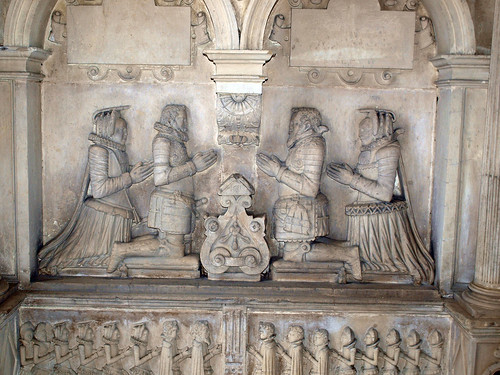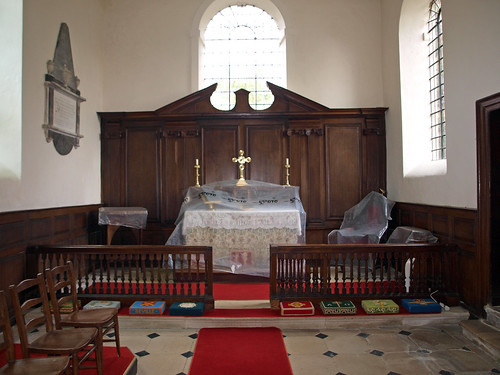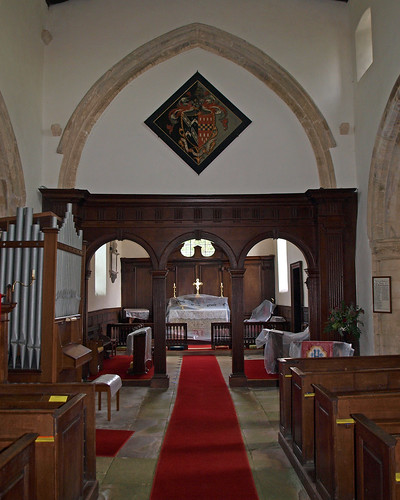ST MICHAEL. A fine E.E. W tower with a small blocked C18 doorway, chamfered buttresses with stop-chamfers, two extremely long lancets to W and W, twin bell-openings under one pointed arch, fully shafted, a corbel-frieze of small heads, and a spire with low broaches and two tiers of lucarnes. Of the same time the S doorway, with early stiff-leaf of not very high quality (including one small head) and an arch of many mouldings. This doorway was provided at the same time as the S aisle and S arcade. The piers alternate between round and octagonal and three capitals have waterleaf, early stiff-leaf, and real stiff-leaf crockets. The N arcade is later C13, of standard elements. The clerestory is Dec. In the C18, probably about 1730, the chancel was rebuilt of ashlar with round-arched windows and a doorway of flat rustication of alternating sizes, the S porch was built, its entrance with a Gibbs surround, and some new aisle windows were put in. It is not known when all this was done. Internally the Georgian work in the chancel is very complete, a SCREEN of three arched openings, a broad REREDOS with coupled Ionic pilasters and a wide open pediment, an ALTAR TABLE on wrought iron supports, a COMMUNION RAIL, and also the PULPIT on a broad base, with a little inlay, and the baluster FONT. - BELL. One is by John Walgrave, i.e. of c.1420-30. - PLATE. Cup and Cover Paten of 1569-70; two undated Cups. - MONUMENTS. Plain tomb-chest to William Beville (Beivele), 1483-4 (anno regis Richard tertii 1o). - Large standing stone monument to Robert Beville d. 1602 and wife and Sir Robert d. 1634 and wife. The date is probably that of the death of Sir Robert’s wife, i.e. 1611. Two kneeling couples, husband and wife facing one another, the children small below. The couples kneel under pendant arches, and there are columns l. and r. Big top achievement. - John Driden 1d. 1707. A fine piece of reredos type. White and veined marble. Pilasters and hanging garlands. No figures. Original iron railings. - Richard Edwards d. 1730. Large oval inscription tablet.
CHESTERTON. It was a busy town seventeen centuries ago; now it is a group of cottages among green fields, its church at the end of a long pathway under trees; but it has one of the most beautiful monuments in the county and traces of its flourishing Roman days.
Known as The Castles, the town was in a great earthwork covering 40 acres in a loop of the River Nene. The Roman Ermine Street runs through it, and we can still see part of it in the green mounds where the defences stood. Roman graves have been found, and a stone coffin in a field near by must have been the last resting-place of one who saw this place in the days when it was famous for its pottery. He would see it with the kilns from which ware was sent to every part of Roman Britain and to the Continent: A busy place this must have been then, a Derby or a Burslem of the Romans. Two Roman milestones have been found, and a Roman who may have looked on them in his journeyings once slept in the big stone coffin here, weighing nearly two tons.
Here is the base of a 15th century cross nearly half as old as the nave of the church, which has Norman stones. There is a fine 13th century tower with a 14th century spire, and a clerestory built about 1330. A modern porch shelters a 13th century doorway with detached shafts, and has faces greeting all who come. There is a small chest made about 1700, bells that have been ringing 400 years, and an inscription to John Dryden, who lived in the village and was proud to see his great poet cousin coming in at the door.
But the glory of Chesterton is a piece of elaborate sculpture as beautiful as anything for miles around. It is in memory of Sir Robert Bevill and his wife, and shows their son with his wife and 17 children. The two husbands and the wives share a curiously carved prayer desk. Every detail of their costume is shown, and in the panels below are the children, all kneeling on cushions, a dozen demure little girls in ruff‘s and caps, and five curly-headed sons. They have been here since Shakespeare’s day, and are one of the loveliest families in stone that we have seen.
Known as The Castles, the town was in a great earthwork covering 40 acres in a loop of the River Nene. The Roman Ermine Street runs through it, and we can still see part of it in the green mounds where the defences stood. Roman graves have been found, and a stone coffin in a field near by must have been the last resting-place of one who saw this place in the days when it was famous for its pottery. He would see it with the kilns from which ware was sent to every part of Roman Britain and to the Continent: A busy place this must have been then, a Derby or a Burslem of the Romans. Two Roman milestones have been found, and a Roman who may have looked on them in his journeyings once slept in the big stone coffin here, weighing nearly two tons.
Here is the base of a 15th century cross nearly half as old as the nave of the church, which has Norman stones. There is a fine 13th century tower with a 14th century spire, and a clerestory built about 1330. A modern porch shelters a 13th century doorway with detached shafts, and has faces greeting all who come. There is a small chest made about 1700, bells that have been ringing 400 years, and an inscription to John Dryden, who lived in the village and was proud to see his great poet cousin coming in at the door.
But the glory of Chesterton is a piece of elaborate sculpture as beautiful as anything for miles around. It is in memory of Sir Robert Bevill and his wife, and shows their son with his wife and 17 children. The two husbands and the wives share a curiously carved prayer desk. Every detail of their costume is shown, and in the panels below are the children, all kneeling on cushions, a dozen demure little girls in ruff‘s and caps, and five curly-headed sons. They have been here since Shakespeare’s day, and are one of the loveliest families in stone that we have seen.



No comments:
Post a Comment